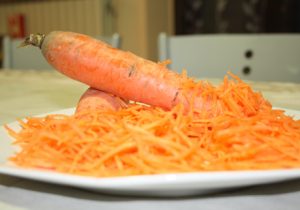
Name
Carota San Rocco Castagnaretta
Seal of quality
Prodotto Agroalimentare Tradizionale (PAT) / Typical Food Farming Product.
Description
The carrot of San Rocco Castagnaretta presents a linear, almost cylindrical taproot, with a short greenish-purplish blue crown, a soft and crispy texture and a sweet taste. Its most important characteristic is its simple method of processing, in fact it is sowed mid June, beginning of July to begin harvesting in autumn which continues throughout the winter, until May the year after. During the winter period, the crop is covered with a thick layer of hay, which protects the taproots from freezing. The taproots are extracted from the ground daily, immediately washed, packed and sold after a few hours from harvest. Therefore, the product, intended almost wholly for fresh consumption, does not undergo any process of preservation (neither in the refrigerator nor in the storehouse), but is immediately sent to the distribution channels. This form of processing is a characteristic of the San Rocco Castagnaretta area, since in other Italian areas of carrot crops they undergo processes of preservation, losing a part of their quality and organoleptic characteristics.
In the area of San Rocco Castagnaretta, they work on the fresh vegetable, an aspect that greatly enhance the carrot’s quality characteristics acquired during its phase of development, thanks to the soil and the particularly suitable area. The soil of this area is, in fact, extremely fertile. Furthermore, a great amount of manure of old cattle coming from livestock farms of the area is spread annually. In order to obtain advantageous results both for the operators and for the crops, three-year and four-year rotations are carried out on the plots concerned, alternating the carrot itself with summer and autumn/winter “verno” cereals and forage. This method of cultivation makes it possible to produce healthy roots, without having to intervene excessively with particular soil treatments.
Nutritional characteristics
Follows the nutritional characteristics of the Carota.
| FOOD | unit of measurement | Carote crude |
|---|---|---|
| Edible part | % | 95 |
| Water | g | 91,6 |
| Protein | g | 1,1 |
| Fat | g | 0,2 |
| Carbohydrates | g | 7,6 |
| Starch | g | 0 |
| Soluble sugar | g | 7,6 |
| Total fibre | g | 3,1 |
| Energy | kcal | 35 |
| Kilojoules | kJ | 147 |
| Sodium | mg | 95 |
| Potassium | mg | 220 |
| Iron | mg | 0,7 |
| Calcium | mg | 44 |
| Phosphor | mg | 37 |
| Thiamine | mg | 0,04 |
| Riboflavin | mg | 0,04 |
| Niacin | mg | 0,7 |
| Vit A ret. eq. | mcg | 1148 |
| Vit C | mg | 4 |
| Vit E | mg |
Area of production
The Carota di San Rocco Castagnaretta is grown in an environment situated in the Piedmontese belt south of the city of Cuneo , specifically in a small fraction of the commune of Cuneo , from which this carrot takes its name. Orthographically speaking, it is situated between the river Stura and the stream Gesso. The ground, therefore, is alluvial, which, having been formed by the overflowing of the two courses of water, is provided with a good percentage of drainage material.
History
Carrot growing in the area of San Rocco Castagnaretta dates way back in time. In fact, in the past, the farming organization of most farms was already based on sharecropping in association with gardening, i.e. on the farm there was a gardener who supplied the farm owners with fruit and vegetable products (we are speaking about 50-60 years ago).
Throughout the years, this characteristic, belonging to the fruit and vegetable farms in San Rocco Castagnaretta, is fading more and more, but, although to a lesser degree, some have maintained their aptitude as regards vegetables, and carrots in particular.
The “Consorzio di tutela della Carita di San Rocco Castagnaretta“, in collaboration with the Farmers’ Association, was founded with the objective of promoting and protecting this crop. The association is provided with a mark, which distinguishes the packing of carrots produced by its members.